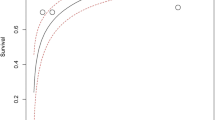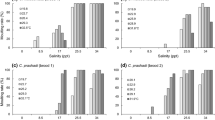Abstract
We investigated the effects of feeding rotifers containing various levels of n-3 highly unsaturated fatty acids (n-3HUFA) to Scylla serrata larvae at different developmental stages on their survival, development, and morphogenesis when they were cultured at six salinity levels. The first-, third-, and fifth (last)-stage zoeae and megalopae were reared to first-stage crabs at salinities of 10, 15, 20, 25, 30, and 35‰, with three different feeding regimes of rotifers containing different levels of n-3HUFA. The larvae successfully developed to the subsequent stages at 20–35‰ salinity. The highest survival rates to first-stage crabs were recorded at 20–25‰ salinity. The morphological features of the megalopa observed in the last-stage zoeae, represented by the ratio of the chela length to carapace length, tended to advance with increasing salinity, indicating higher assimilation efficiency at higher salinities. The megalopal features of the last-stage zoeae were enhanced when the larvae were fed rotifers containing higher amounts of docosahexaenoic acid (DHA). As reported previously, final-stage zoeal larvae with advanced megalopal features often experienced moult death syndrome (MDS). These results show that when larvae are fed rotifers with high DHA under high-salinity conditions, morphogenesis is accelerated, resulting in MDS. Therefore, to evaluate the effects of salinity on larval survival, it is necessary to examine larval morphogenesis in terms of MDS. In conclusion, we recommend that not only survival but also larval morphogenesis should be examined when evaluating the results of rearing experiments with S. serrata larvae.



Similar content being viewed by others
Abbreviations
- n-3HUFA:
-
n-3 highly unsaturated fatty acids
- DHA:
-
Docosahexaenoic acid
- EPA:
-
Eicosapentaenoic acid
- ARA:
-
Arachidonic acid
- LNA:
-
Linolenic acid
- Z1–Z5:
-
First-to-fifth-stage zoeae
- MG:
-
Megalopa
- C1:
-
First-stage crab
- MDS:
-
Moult death syndrome
References
Anger K (1991) Effects of temperature and salinity on the larval development of the Chinese mitten crab Eriocheir sinensis (Decapoda: Grapsidae). Mar Ecol Prog Ser 72:103–110
Anger K (1996) Salinity tolerance of the larvae and first juveniles of a semiterrestrial grapsid crab, Armases miersii (Rathbun). J Exp Mar Biol Ecol 202:205–223
Anger K (2001) Energy partitioning. In: The biology of decapod crustacean larvae. Crustacean Issues, vol 14. A. A. Balkema, Leiden, The Netherlands, pp 245–261
Anger K, Spivak E, Luppi T (1998) Effects of reduced salinities on development and bioenergetics of early larval shore crab, Carcinus maenas. J Exp Mar Biol Ecol 220:287–304
Anger K, Riesebeck K, Püschel C (2000) Effects of salinity on larval and early juvenile growth of an extremely euryhaline crab species, Armases miersii (Decapoda: Grapsidae). Hydrobiologia 426:161–168
Arai D, Hamasaki K, Maruyama K, Obata Y, Tsumura S, Takano M (2004) Relationship between mass mortality of megalops and morphogenesis of zoeas in the seed production of swimming crab Portunus trituberculatus (Brachyura: Portunidae)(in Japanese with English abstract). Nippon Suisan Gakkaishi 70:567–572
Arai D, Takeuchi T, Sugita D, Hamasaki K, Maruyama K (2007) Effect of n-3HUFA-Chlorella supplied to rearing tank on morphogenesis of swimming crab zoeas of the Portunus trituberculatus (Brachyura: Portunidae)(in Japanese with English abstract). Aquacult Sci 55:133–134
Baylon JC (2009) Appropriate food type, feeding schedule and Artemia density for the zoea larvae of the mud crab, Scylla tranquebarica (Crustacea: Decapoda: Portunidae). Aquaculture 288:190–195. doi:10.1016/j.aquaculture.200811.028
Baylon JC, Failaman AN, Vengano EL (2001) Effect of salinity on survival and metamorphosis from zoea to megalopa of the mud crab Scylla serrata Forskål (Crustacea: Portunidae). Asian Fish Sci 14:143–151
Baylon JC, Bravo ME, Maningo NC (2004) Ingestion of Brachionus plicatilis and Artemia salina nauplii by mud crab Scylla serrata larvae. Aquacult Res 35:62–70
Chou R, Lee HB (1997) Commercial marine fish farming in Singapore. Aquacult Res 28:767–776
Dan S, Koiso M (2008) Effect of microalgal addition on stability of n-3HUFA contents in enriched rotifer Brachionus plicatilis in large tank for seed production (in Japanese with English abstract). Aquacult Sci 56:603–604
Davis JA, Wille M, Hecht T, Sorgeloos P (2005a) Optimal first feed organism for South African mud crab Scylla serrata (Forskål) larvae. Aquacult Int 13:187–201. doi:10.1007/s10499-044-1496-8
Davis JA, Wille M, Hecht T, Sorgeloos P (2005b) Optimum time for weaning South African mud crab Scylla serrata (Forskål) larvae from rotifers to Artemia. Aquacult Int 14:203–216. doi:10.1007/s10499-044-1915-x
Development Core Team R (2009) R: A language and environment for statistical computing. R Foundation for Statistical Computing, Vienna, Austria
Folch J, Lees M, Stanley GH (1957) A simple method for the isolation and purification of total lipids from animal tissues. J Biol Chem 226:497–507
Fushimi H (1983) Stock enhancement trials of the mud crab in the Hamana-ko Lake. In: Oshima Y (ed) Tsukuru Gyogyou (in Japanese). Shigen-kyoukai, Tokyo, pp 652–658
Genodepa J, Southgate PC, Zeng C (2004a) Diet particle size preference and optimal relation for mud crab, Scylla serrata, larvae fed microbound diets. Aquaculture 230:493–505. doi:10.1016/j.aquaculture.2003.09.009
Genodepa J, Zeng C, Southgate PC (2004b) Preliminary assessment of a microbound diet as an Artemia replacement for mud crab, Scylla serrata, megalopa. Aquaculture 236:497–509. doi:10.1016/j.aquaculture.2004.02.007
Hamasaki K (2003) Effects of temperature on the egg incubation period, survival and developmental period of larvae of the mud crab Scylla serrata (Forskål) (Brachyura: Portunidae) reared in the laboratory. Aquaculture 219:561–572. doi:10.1016/S0044-8486(02)00662-2
Hamasaki K, Suprayudi MA, Takeuchi T (2002a) Mass mortality during metamorphosis to megalops in the seed production of mud crab Scylla serrata (Crustacea, Decapoda, Portunidae). Fish Sci 68:1226–1232. doi:10.1046/j.1444-2906.2002.00559.x
Hamasaki K, Suprayudi MA, Takeuchi T (2002b) Effect of dietary n-3HUFA on larval morphogenesis and metamorphosis to megalops in the seed production of mud crab, Scylla serrata (Brachyura: Portunidae). Aquacult Sci 50:333–340
Heasman MP, Fielder DR (1983) Laboratory spawning and mass rearing of the mangrove crab, Scylla serrata (Forskål), from first zoea to first crab stage. Aquaculture 34:303–316. doi:10.1016/0044-8486(83)90210-7
Hill BJ (1974) Salinity and temperature tolerance of zoeae of the portunid crab Scylla serrata. Mar Biol 25:21–24
Hill BJ (1994) Offshore spawning by the portunid crab Scylla serrata (Crustacea: Decapoda). Mar Biol 120:379–384
Holm S (1979) A simple sequentially rejective multiple test procedure. Scand J Stat 6:65–70
Holm MH, Zeng C, Southgate PC (2006) Use of microbound diets for larval culture of the mud crab, Scylla serrata. Aquaculture 257:482–490. doi:10.1016/j.aquaculture.2006.03.014
Hyland SJ, Hill BJ, Lee CP (1984) Movement within and between different habitats by the portunid crab Scylla serrata. Mar Biol 80:57–61
Ito M (2000) Some observations on the release and catch of mud crabs (Scylla spp.) in Lake Hamana, Pacific coast of central Japan on the basis of past records (in Japanese). Saibai Giken 28:57–64
Keenan CP (1999a) The fourth species of Scylla. In: Keenan CP, Blackshaw A (eds) Mud crab aquaculture and biology. ACIAR Proceedings, vol 78. ACIAR, Canberra, Australia, pp 48–58
Keenan CP (1999b) Aquaculture of the mud crab, genus Scylla—past, present and future. In: Keenan CP, Blackshaw A (eds) Mud crab aquaculture and biology. ACIAR Proceedings, vol 78. ACIAR, Canberra, Australia, pp 9–13
Le Vay L, Lebata MJH, Walton M, Primavera J, Quinitio E, Lavilla-Pitogo C, Parado-Estepa F, Rodriguez E, Ut VN, Nghia TT, Sorgeloos P, Wille M (2008) Approaches to stock enhancement in mangrove-associated crab fisheries. Rev Fish Sci 16:78–80. doi:10.1080/10641260701727285
Lebata MJH, Le Vay L, Walton M, Binas JB, Quinitio ET, Rodriguez EM, Primavera JH (2009) Evaluation of hatchery-based enhancement of the mud crab Scylla spp., fisheries in mangroves: comparison of species and release strategies. Mar Fresh Res 60:58–69. doi:10.1071/MF08155
Mann D, Asakawa T, Pizzutto M (1999) Development of a hatchery system for larvae of the mud crab Scylla serrata at the Bribie Island Aquaculture Research Centre. In: Keenan CP, Blackshaw A (eds) Mud crab aquaculture and biology. ACIAR Proceedings, vol 78. ACIAR, Canberra, Australia, pp 153–158
Marte CL (2003) Larviculture of marine species in Southeast Asia: current research and industry prospects. Aquaculture 227:293–304. doi:10.1016/s0044-8486(03)00510-6
Nurdiani R, Zeng C (2007) Effects of temperature and salinity on the survival and development of mud crab, Scylla serrata (Forskål), larvae. Aquacult Res 38:1529–1538. doi:10.1111/j.1365-2109.2007.01810.x
Oshiro N (1988) Mangrove crabs (Scylla spp.). In: Shokita S (ed) Aquaculture in tropical areas (in Japanese). Midorishobo, Tokyo, pp 198–209
Quinitio ET, Parado-Estepa FD, Millamena OM, Rodriguez E, Borlongan E (2001) Seed production of mud crab Scylla serrata juveniles. Asian Fish Sci 14:161–174
Rabbani AG, Zeng C (2005) Effects of tank colour on larval survival and development of mud crab Scylla serrata (Forskål). Aquacult Res 36:1112–1119. doi:10.1111/j.1365-2109.2005.01328.x
Ruscoe IM, Williams GR, Shelley CC (2004) Limiting the use of rotifers to the first zoeal stage in mud crab (Scylla serrata Forskål) larval rearing. Aquaculture 231:517–527. doi:10.1016/j.aquaculture.2003.11.021
Suprayudi MA, Takeuchi T, Hamasaki K, Hirokawa J (2002a) The effect of n-3HUFA content in rotifers on the development and survival of mud crab Scylla serrata larvae. Aquacult Sci 50:205–212
Suprayudi MA, Takeuchi T, Hamasaki K, Hirokawa J (2002b) Effect of Artemia feeding schedule and density on the survival and development of larval mud crab Scylla serrata. Fish Sci 68:1295–1303. doi:10.1046/j.1444-2906.2002.00567.x
Suprayudi MA, Takeuchi T, Hamasaki K (2004) Essential fatty acids for larval mud crab Scylla serrata: implications of the lack of ability to bioconvert C18 unsaturated fatty acid to highly unsaturated fatty acids. Aquaculture 231:403–416. doi:10.1016/S0044-8486(03)00542-8
Takano M, Arai D, Obata Y, Tsumura S, Ashidate M (2004) Effect of microalgal addition to the mass seed production tank on morphogenesis of fifth stage zoea of mud crab Scylla paramamosain (in Japanese). Tech Rep Natl Center Stock Enhancement 2:27–30
Torres G, Giménez L, Anger K (2002) Effects of reduced salinity on the biochemical composition (lipid, protein) of zoea 1 decapod crustacean larvae. J Exp Mar Biol Ecol 277:43–60
Triño AT, Rodriguez EM (2002) Pen culture of mud crab Scylla serrata in tidal flats reforested with mangrove trees. Aquaculture 221:125–134
Wang G, Li S, Zeng C, Lin S, Kong X, Ai C, Lin Q (2005) Status of biological studies and aquaculture development of the mud crab, Scylla serrata, in China: an experimental ecological study. Aquacult Int 13:459–468. doi:10.1007/s10499-055-1887-5
Acknowledgments
We would like to thank the staff of the Yaeyama Station of the National Center for Stock Enhancement, Fisheries Research Agency, for their support with the laboratory work.
Author information
Authors and Affiliations
Corresponding author
Rights and permissions
About this article
Cite this article
Dan, S., Hamasaki, K. Effects of salinity and dietary n-3 highly unsaturated fatty acids on the survival, development, and morphogenesis of the larvae of laboratory-reared mud crab Scylla serrata (Decapoda, Portunidae). Aquacult Int 19, 323–338 (2011). https://doi.org/10.1007/s10499-010-9374-z
Received:
Accepted:
Published:
Issue Date:
DOI: https://doi.org/10.1007/s10499-010-9374-z




